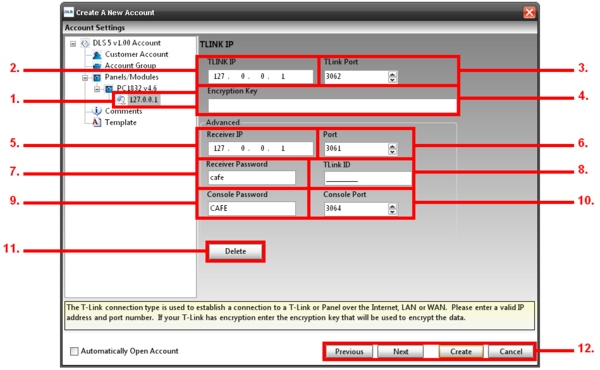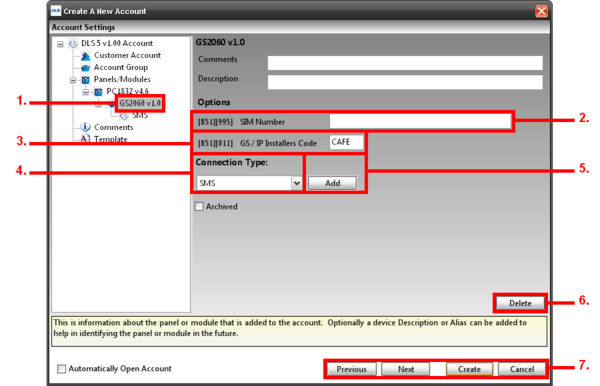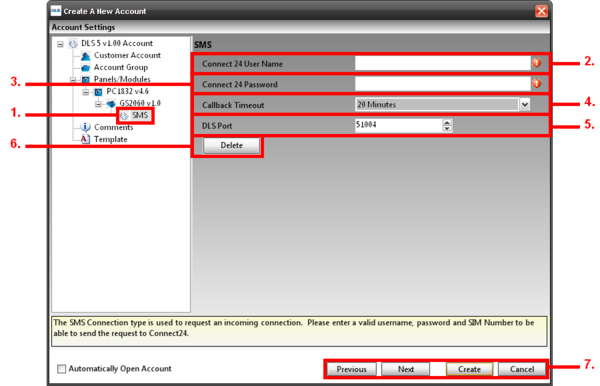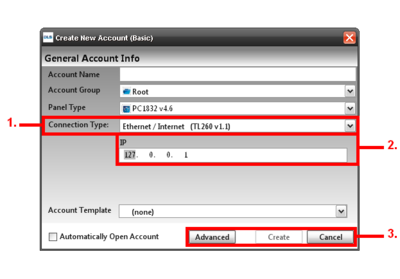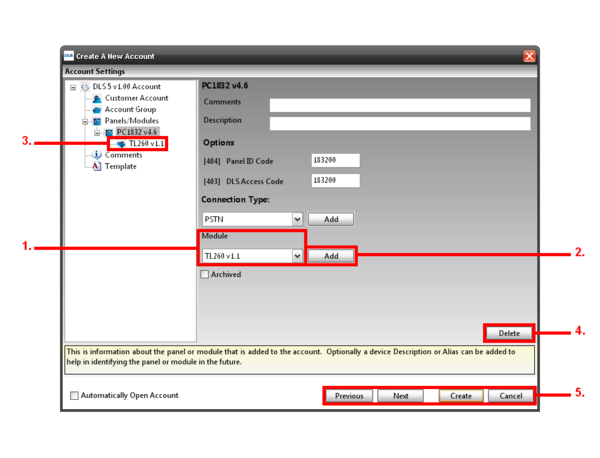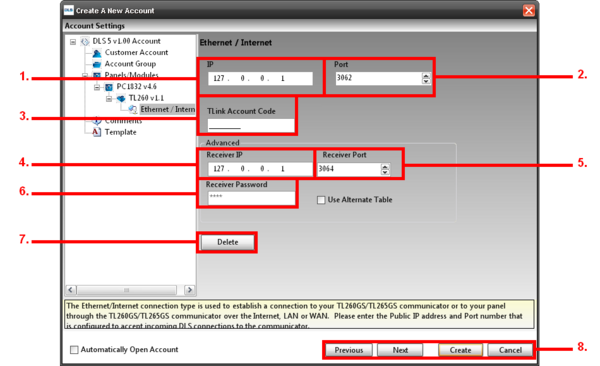Difference between revisions of "Communications Tutorial"
(→Basic PSTN Setup) |
Jvankooten (Talk | contribs) |
||
| (7 intermediate revisions by one user not shown) | |||
| Line 10: | Line 10: | ||
PSTN stands for Public Switched Telephone Network. In plain terms, phone line. | PSTN stands for Public Switched Telephone Network. In plain terms, phone line. | ||
| − | By selecting this option you will be using the configured modem to dial into the panel. There are 2 | + | By selecting this option you will be using the configured modem to dial into the panel. There are 2 mode |
| − | + | ||
MD-12 - available from DSC | MD-12 - available from DSC | ||
| Line 19: | Line 18: | ||
===Basic PSTN Setup=== | ===Basic PSTN Setup=== | ||
| − | [[Image | + | [[Image.png|400px|right|thumb|Ba PSTN Setup]] |
| + | 1. Connection Type: The method the panel would be connecting Under Connection Type, make sure it is set to PSTN. | ||
| − | + | 2. Phone Number: This will prompt up new options to add the Phone Number, enter your phone number, if it requires a 1 or a 9 to dial out from that location, enter that with the following phone number. | |
| − | + | 3. Double Call: This will also prompt up to have Double Call enabled, it will allow you to hangup and be able call if that feature will be used. | |
| − | + | 4. Advanced: Click on Advanced to go to the advanced options for PSTN. | |
| − | + | ||
| − | 4. Advanced: Click on | + | |
===Advanced PSTN Setup=== | ===Advanced PSTN Setup=== | ||
| − | [[ | + | [[ImaSTNa.png|600px|right|thumb|Advance PSTN Setup]] |
| Line 40: | Line 38: | ||
3. Double Call Enable: If Double Call was enabled on the previous section it would show up here. | 3. Double Call Enable: If Double Call was enabled on the previous section it would show up here. | ||
| − | 4. Double Call Timer: Allows the maximum amount of time in minutes between calls when connecting to a | + | 4. Double Call Timer: Allows the maximum amount of time in minutes between calls when connecting to a pa |
| − | + | ||
5. Double Call Duration: Allows the maximum amount of time in minutes before double call hangs up. | 5. Double Call Duration: Allows the maximum amount of time in minutes before double call hangs up. | ||
| Line 47: | Line 44: | ||
7. This will allow you to create/cancel or go to the next/previous section | 7. This will allow you to create/cancel or go to the next/previous section | ||
| − | |||
| − | |||
| − | |||
| − | |||
| − | |||
| − | |||
| − | |||
| − | |||
| − | |||
| − | |||
| − | |||
| − | |||
| − | |||
| − | |||
| − | |||
| − | |||
| − | |||
| − | |||
| − | |||
| − | |||
| − | |||
| − | |||
| − | |||
| − | |||
== IP (T-Link) == | == IP (T-Link) == | ||
| − | By selecting IP, you will be connecting to the account using a network connection through the TL-250 module | + | By selecting IP, you will be connecting to the account using a network connection through the TL-250 module. You need to provide the IP address of the T-Link you will be connecting to. This can be done when you are creating your account or by going into the account properties. |
You will also need to make sure all the appropriate ports for the communication are open. | You will also need to make sure all the appropriate ports for the communication are open. | ||
| Line 82: | Line 55: | ||
===Basic IP (T-Link) Setup=== | ===Basic IP (T-Link) Setup=== | ||
| − | [[Image: | + | [[Image:IP_00px|right|thumb|Basic IP (T-Link) Setup]] |
| − | 1. Connection Type: Under | + | 1. Connection Type: Under Connection Type, make sure T Link is selected, this will prompt up new options to add the IP address and the Encryption Key. |
2. IP: Enter the public IP address of the T Link module that is being used. | 2. IP: Enter the public IP address of the T Link module that is being used. | ||
| Line 91: | Line 64: | ||
3. Encryption Key: Add an encryption key if the monitoring station requires reporting codes to be encrypted. | 3. Encryption Key: Add an encryption key if the monitoring station requires reporting codes to be encrypted. | ||
| − | 4. Advanced: Click on | + | 4. Advanced: Click on Advanced to go to the advanced options for T Link 250. |
| Line 114: | Line 87: | ||
3. T Link Port: The port that the T Link would be using for communication, default port is 3062. | 3. T Link Port: The port that the T Link would be using for communication, default port is 3062. | ||
| − | 4. Encryption Key: The encryption key was entered in previous section. | + | 4. Encryption Key: The encryption key was entered in the previous section. |
5. Receiver IP: The IP Address of the Central Station. | 5. Receiver IP: The IP Address of the Central Station. | ||
| − | 6. Port: The port the Central Station would be using for communication, default port | + | 6. Port: The port the Central Station would be using for communication, default port is 3061. |
| − | 7. Receiver Password: The password used by Central Station to connect to the T Link, default password is | + | 7. Receiver Password: The password used by Central Station to connect to the T Link, default password is CAFE. |
8. T Link ID: ID number associated to the T Link module. | 8. T Link ID: ID number associated to the T Link module. | ||
| − | 9. Console Password: Password required to connect to the T Link Console, default the password is | + | 9. Console Password: Password required to connect to the T Link Console, default the password is CAFE. |
10. Console Port: The port for the T Link Console software to connect to the T Link. | 10. Console Port: The port for the T Link Console software to connect to the T Link. | ||
| Line 131: | Line 104: | ||
12. This will allow you to create/cancel or go to the next/previous section. | 12. This will allow you to create/cancel or go to the next/previous section. | ||
| − | |||
| − | |||
| − | |||
| − | |||
| − | |||
| − | |||
| − | |||
| − | |||
| − | |||
== SMS (GS2060/GS2065 or TL260GS/TL265GS) == | == SMS (GS2060/GS2065 or TL260GS/TL265GS) == | ||
| − | An SMS message is sent to the wireless GSM module to trigger a return connection to the waiting DLS 5 | + | An SMS message is sent to the wireless GSM module to trigger a return connection to the waiting DLS 5 . To use this connection, the SIM number is used as the unique Identifier. Ensure the full SIM number is entered. |
| − | + | ||
| − | + | ||
| − | There is a | + | One key advantage of using the SMS connection type is that there is NO PORT FORWARD required on the installation. Instead, there is a single port forward required on the DLS 5 PC's network allow the incoming c |
| + | There is a of time required to connect via SMS connection type. This is due to the delays introduced at each juncture of the connection process. Please be patient, connection times of 2-5 mins are normal. | ||
| Line 160: | Line 123: | ||
| − | 1. Connection Type: Under | + | 1. Connection Type: Under Connection Type, make sure GS2060 is selected this will prompt up new options |
| − | + | ||
| − | + | ||
| − | + | ||
| − | + | ||
| − | + | ||
| − | + | ||
| − | + | ||
| − | + | ||
| − | + | ||
| + | 2. Connect 24 User Name: Add the Connect 24 User Name you used to register with Connect 24 | ||
| + | 3. Connect 24 Password: Add the Connect 24 Password. you used to register with Connect 24 | ||
| + | 4. Advanced: Click on Advanced to go to the advanced options for the GS2060. | ||
===Advanced SMS (GS2060/GS2065 or TL260GS/TL265GS)Setup=== | ===Advanced SMS (GS2060/GS2065 or TL260GS/TL265GS)Setup=== | ||
| Line 182: | Line 139: | ||
2. SIM Number: This would be the subscriber identity module (SIM) number that is found on the SIM card for the GS2060 to communicate. | 2. SIM Number: This would be the subscriber identity module (SIM) number that is found on the SIM card for the GS2060 to communicate. | ||
| − | 3. GS/IP Installers Code: The password required to connect to the GS2060 Console, by default the password should be | + | 3. GS/IP Installers Code: The password required to connect to the GS2060 Console, by default the password should be CAFE. |
4. Connection Type: The type of connection the GS2060 will use to connect; SMS is the only options for the GS2060 | 4. Connection Type: The type of connection the GS2060 will use to connect; SMS is the only options for the GS2060 | ||
| Line 209: | Line 166: | ||
1. SMS: Under the DLS 5 Account heading on the left side, select SMS this will bring up the GS SMS options. | 1. SMS: Under the DLS 5 Account heading on the left side, select SMS this will bring up the GS SMS options. | ||
| − | 2. Connect 24 User Name: Add the | + | 2. Connect 24 User Name: Add the Connect 24 User Name you used to register with Connect 24. |
| − | 3. Connect 24 Password: Add the | + | 3. Connect 24 Password: Add the Connect 24 Password. you used to register with Connect 24. |
4. Callback Timeout: The amount of time allowed for the GSM to do a call back. | 4. Callback Timeout: The amount of time allowed for the GSM to do a call back. | ||
| Line 220: | Line 177: | ||
7. This will allow you to create/cancel or go to the next/previous section. | 7. This will allow you to create/cancel or go to the next/previous section. | ||
| − | |||
| − | |||
| − | |||
| − | |||
| − | |||
| − | |||
| − | |||
| − | |||
| − | |||
| − | |||
| − | |||
| − | |||
| − | |||
| − | |||
| − | |||
| − | |||
| − | |||
| − | |||
| − | |||
| − | |||
| − | |||
| − | |||
| − | |||
== Ethernet/Internet (TL260GS/TL265GS) == | == Ethernet/Internet (TL260GS/TL265GS) == | ||
| Line 249: | Line 183: | ||
This connection type is NEW to DLS, and is DLS's '''fastest''' connection. Global upload and download times are reduced to seconds with this connection type. | This connection type is NEW to DLS, and is DLS's '''fastest''' connection. Global upload and download times are reduced to seconds with this connection type. | ||
| − | An "Ethernet/Internet" connection is | + | An "Ethernet/Internet" connection is installed TL260GS/TL265GS communicator. will require a port is available on the install-site end to accept the direct connection. |
To use this connection type, you will need: | To use this connection type, you will need: | ||
* The TL260GS/TL265GS must already be configured with an IP and have a connection to the internet | * The TL260GS/TL265GS must already be configured with an IP and have a connection to the internet | ||
| − | * TL260GS/ | + | * TL260GS/TL |
| − | + | ||
| − | + | ||
| − | + | ||
| − | + | ||
| Line 269: | Line 199: | ||
| − | 1. Connection Type: Under | + | 1. Connection Type: Under Connection Type, make sure TL 260 is selected, this will ions to |
| − | add the | + | add the IP address. |
2. IP: Enter the public IP address of the T Link module that is being used. | 2. IP: Enter the public IP address of the T Link module that is being used. | ||
| − | |||
| − | |||
| Line 298: | Line 226: | ||
| − | 1. Module: Under | + | 1. Module: Under Module, make sure it is set to TL260. |
| − | 2. Add: Click | + | 2. Add: Click add to add |
3. TL 260 v1.1: It will now show up under your panel drop down list. | 3. TL 260 v1.1: It will now show up under your panel drop down list. | ||
| Line 312: | Line 240: | ||
| − | + | 1. GS/IP Installer Code: The password required to connect to the T Link Console Software, by default the password should be CAFE. | |
| − | + | ||
| − | + | ||
| − | + | ||
| − | + | ||
| − | + | ||
| − | + | ||
| − | + | ||
| − | + | ||
| − | + | ||
| − | + | ||
| − | + | ||
| − | + | ||
| − | + | ||
| − | + | ||
| − | + | ||
| − | + | ||
| − | + | ||
| − | + | ||
| − | + | ||
| − | + | ||
| − | + | ||
| − | + | ||
| − | + | ||
| − | 1. GS/IP Installer Code: The password required to connect to the T Link Console Software, by default the password should be | + | |
2. Connection Type: The type of connection the T Link will use to connect; Ethernet/Internet is the only option for the TL 260. | 2. Connection Type: The type of connection the T Link will use to connect; Ethernet/Internet is the only option for the TL 260. | ||
| − | 3. Add: Click | + | 3. Add: Click add in order for the Ethernet/Internet connection type to be added under the TL 260. |
4. Ethernet/Intern: This connection type will be added under the panel drop down list, when selected it will take you to the advance TL 260 programming. | 4. Ethernet/Intern: This connection type will be added under the panel drop down list, when selected it will take you to the advance TL 260 programming. | ||
| Line 368: | Line 272: | ||
2. Port: The port that the T Link would be using for communication, the default port should be 3062. | 2. Port: The port that the T Link would be using for communication, the default port should be 3062. | ||
| − | 3. T Link Account Code: This would be | + | 3. T Link Account Code: This would be thf the T Link module that the central station would be receiving. |
4. Receiver IP: This would be the IP Address of the receiver that the T Link communicates to. | 4. Receiver IP: This would be the IP Address of the receiver that the T Link communicates to. | ||
| Line 374: | Line 278: | ||
5. Receiver Port: This would be the Port of the receiver that the T Link communicates to, the default port is 3064. | 5. Receiver Port: This would be the Port of the receiver that the T Link communicates to, the default port is 3064. | ||
| − | 6. | + | 6. |
| − | + | ||
| − | + | ||
| − | + | ||
| − | + | ||
| − | + | ||
| − | + | ||
| − | + | ||
| − | + | ||
| − | + | ||
| − | + | ||
| − | + | ||
| − | + | ||
| − | + | ||
| − | + | ||
| − | + | ||
| − | + | ||
| − | + | ||
| − | + | ||
| − | + | ||
| − | + | ||
| − | + | ||
| − | + | ||
| − | + | ||
| − | + | ||
| Line 408: | Line 288: | ||
Once you have selected the type of communication operation, a screen will appear with 3 tabs prompting you with different options. | Once you have selected the type of communication operation, a screen will appear with 3 tabs prompting you with different options. | ||
| − | Under the "Basic" tab, you can verify the panel you are connecting to, the type of connection | + | Under the "Basic" tab, you can verify the panel you are connecting to, the type of connection |
| − | + | ||
There is also a button "Show Tags". This will display for you exactly which sections have been tagged for communications. | There is also a button "Show Tags". This will display for you exactly which sections have been tagged for communications. | ||
| Line 421: | Line 300: | ||
If you would like to upload the event buffer, without upload or downloading any other sections, you can select "Upload Event Buffer" from the toolbar. | If you would like to upload the event buffer, without upload or downloading any other sections, you can select "Upload Event Buffer" from the toolbar. | ||
| − | |||
| − | |||
===Module Auto-Detect=== | ===Module Auto-Detect=== | ||
| − | If you would like to find out what modules are enrolled on the system, without uploading or downloading any programming | + | If you would like to find out what modules are enrolled on the system, without uploading or downloading any programming , you can select the "Module Auto-Detect" function from the toolbar. |
[[Image:ModuleAutoDetect.png]] | [[Image:ModuleAutoDetect.png]] | ||
Latest revision as of 19:26, 12 May 2015
Contents
[hide]Connection Types
In order to connect to a panel, you must first decide which type of connection you wish to use. The following options are available.
PSTN
PSTN stands for Public Switched Telephone Network. In plain terms, phone line.
By selecting this option you will be using the configured modem to dial into the panel. There are 2 mode MD-12 - available from DSC
Multi-Tech 56k - widely available around the globe. Model #MT5634ZBA-V-V92-NAM (or similar).
Basic PSTN Setup
400px|right|thumb|Ba PSTN Setup
1. Connection Type: The method the panel would be connecting Under Connection Type, make sure it is set to PSTN.
2. Phone Number: This will prompt up new options to add the Phone Number, enter your phone number, if it requires a 1 or a 9 to dial out from that location, enter that with the following phone number.
3. Double Call: This will also prompt up to have Double Call enabled, it will allow you to hangup and be able call if that feature will be used.
4. Advanced: Click on Advanced to go to the advanced options for PSTN.
Advanced PSTN Setup
600px|right|thumb|Advance PSTN Setup
1. PSTN: Under the DLS Account heading on the left side, select PSTN this will bring up the PSTN advanced options.
2. Phone Number: The phone number entered in the previous section would show up here.
3. Double Call Enable: If Double Call was enabled on the previous section it would show up here.
4. Double Call Timer: Allows the maximum amount of time in minutes between calls when connecting to a pa 5. Double Call Duration: Allows the maximum amount of time in minutes before double call hangs up.
6. Delete: Allows you to remove the PSTN connection from the panel
7. This will allow you to create/cancel or go to the next/previous section
IP (T-Link)
By selecting IP, you will be connecting to the account using a network connection through the TL-250 module. You need to provide the IP address of the T-Link you will be connecting to. This can be done when you are creating your account or by going into the account properties.
You will also need to make sure all the appropriate ports for the communication are open.
*If you are unsure how to open the ports, contact your network administrator
Basic IP (T-Link) Setup
1. Connection Type: Under Connection Type, make sure T Link is selected, this will prompt up new options to add the IP address and the Encryption Key.
2. IP: Enter the public IP address of the T Link module that is being used.
3. Encryption Key: Add an encryption key if the monitoring station requires reporting codes to be encrypted.
4. Advanced: Click on Advanced to go to the advanced options for T Link 250.
Advanced IP (T-Link) Setup
1. 127.0.0.1: The account heading on the left side select the IP Address, this will bring up the TL 250 advanced options.
2. T Link IP: The IP Address entered in the previous section would show up here.
3. T Link Port: The port that the T Link would be using for communication, default port is 3062.
4. Encryption Key: The encryption key was entered in the previous section.
5. Receiver IP: The IP Address of the Central Station.
6. Port: The port the Central Station would be using for communication, default port is 3061.
7. Receiver Password: The password used by Central Station to connect to the T Link, default password is CAFE.
8. T Link ID: ID number associated to the T Link module.
9. Console Password: Password required to connect to the T Link Console, default the password is CAFE.
10. Console Port: The port for the T Link Console software to connect to the T Link.
11. Delete: Allows you to remove the T Link connection from the panel.
12. This will allow you to create/cancel or go to the next/previous section.
SMS (GS2060/GS2065 or TL260GS/TL265GS)
An SMS message is sent to the wireless GSM module to trigger a return connection to the waiting DLS 5 . To use this connection, the SIM number is used as the unique Identifier. Ensure the full SIM number is entered.
One key advantage of using the SMS connection type is that there is NO PORT FORWARD required on the installation. Instead, there is a single port forward required on the DLS 5 PC's network allow the incoming c There is a of time required to connect via SMS connection type. This is due to the delays introduced at each juncture of the connection process. Please be patient, connection times of 2-5 mins are normal.
For more information, see these articles:
Basic SMS (GS2060/GS2065 or TL260GS/TL265GS)Setup
1. Connection Type: Under Connection Type, make sure GS2060 is selected this will prompt up new options
2. Connect 24 User Name: Add the Connect 24 User Name you used to register with Connect 24
3. Connect 24 Password: Add the Connect 24 Password. you used to register with Connect 24
4. Advanced: Click on Advanced to go to the advanced options for the GS2060.
Advanced SMS (GS2060/GS2065 or TL260GS/TL265GS)Setup
1. GS2060 v 1.0: Under the DLS 5 Account heading on the left side, select GS2060 v 1.0 this will bring up the GS 2060 advanced options.
2. SIM Number: This would be the subscriber identity module (SIM) number that is found on the SIM card for the GS2060 to communicate.
3. GS/IP Installers Code: The password required to connect to the GS2060 Console, by default the password should be CAFE.
4. Connection Type: The type of connection the GS2060 will use to connect; SMS is the only options for the GS2060
5. Add: This will bring the SMS options.
6. Allows you to remove the SMS connection from the panel
7. This will allow you to create/cancel or go to the next/previous section.
SMS Setup(GS2060/GS2065 or TL260GS/TL265GS)
1. SMS: Under the DLS 5 Account heading on the left side, select SMS this will bring up the GS SMS options.
2. Connect 24 User Name: Add the Connect 24 User Name you used to register with Connect 24.
3. Connect 24 Password: Add the Connect 24 Password. you used to register with Connect 24.
4. Callback Timeout: The amount of time allowed for the GSM to do a call back.
5. DLS Port: The port that the GS2060 would be using for communication, the default port should be 51004.
6. Delete: Allows you to remove the SMS connection from the panel.
7. This will allow you to create/cancel or go to the next/previous section.
Ethernet/Internet (TL260GS/TL265GS)
This connection type is NEW to DLS, and is DLS's fastest connection. Global upload and download times are reduced to seconds with this connection type.
An "Ethernet/Internet" connection is installed TL260GS/TL265GS communicator. will require a port is available on the install-site end to accept the direct connection.
To use this connection type, you will need:
- The TL260GS/TL265GS must already be configured with an IP and have a connection to the internet
- TL260GS/TL
Basic TL260/260R/2603GR/265 Setup
There are two ways to add a TL 260 to your panel:
1st Method
1. Connection Type: Under Connection Type, make sure TL 260 is selected, this will ions to
add the IP address.
2. IP: Enter the public IP address of the T Link module that is being used.
2nd Method
1. Module: Under Module, make sure it is set to TL260.
2. Add: Click add to add
3. TL 260 v1.1: It will now show up under your panel drop down list.
4. Delete: Allows you to remove the TL 260 module from the panel.
5. This will allow you to create/cancel or go to the next/previous section.
1. GS/IP Installer Code: The password required to connect to the T Link Console Software, by default the password should be CAFE.
2. Connection Type: The type of connection the T Link will use to connect; Ethernet/Internet is the only option for the TL 260.
3. Add: Click add in order for the Ethernet/Internet connection type to be added under the TL 260.
4. Ethernet/Intern: This connection type will be added under the panel drop down list, when selected it will take you to the advance TL 260 programming.
5. Delete: Allows you to remove the Ethernet/internet connection from the panel.
6. This will allow you to create/cancel or go to the next/previous section.
TL260/260R/2603GR/265 IP Setup
1. IP: This would be the IP Address of the T Link in order to communicate.
2. Port: The port that the T Link would be using for communication, the default port should be 3062.
3. T Link Account Code: This would be thf the T Link module that the central station would be receiving.
4. Receiver IP: This would be the IP Address of the receiver that the T Link communicates to.
5. Receiver Port: This would be the Port of the receiver that the T Link communicates to, the default port is 3064.
6.
Connecting to the Panel
First you must choose the desired communications operation (Global upload, Global Download, Communicate Tags, etc).
Once you have selected the type of communication operation, a screen will appear with 3 tabs prompting you with different options.
Under the "Basic" tab, you can verify the panel you are connecting to, the type of connection
There is also a button "Show Tags". This will display for you exactly which sections have been tagged for communications.
Under the "Options" tab you can turn on/off the double call feature. You can also specify the double call timer and the double call duration.
Upload Event Buffer
If you would like to upload the event buffer, without upload or downloading any other sections, you can select "Upload Event Buffer" from the toolbar.
Module Auto-Detect
If you would like to find out what modules are enrolled on the system, without uploading or downloading any programming , you can select the "Module Auto-Detect" function from the toolbar.
